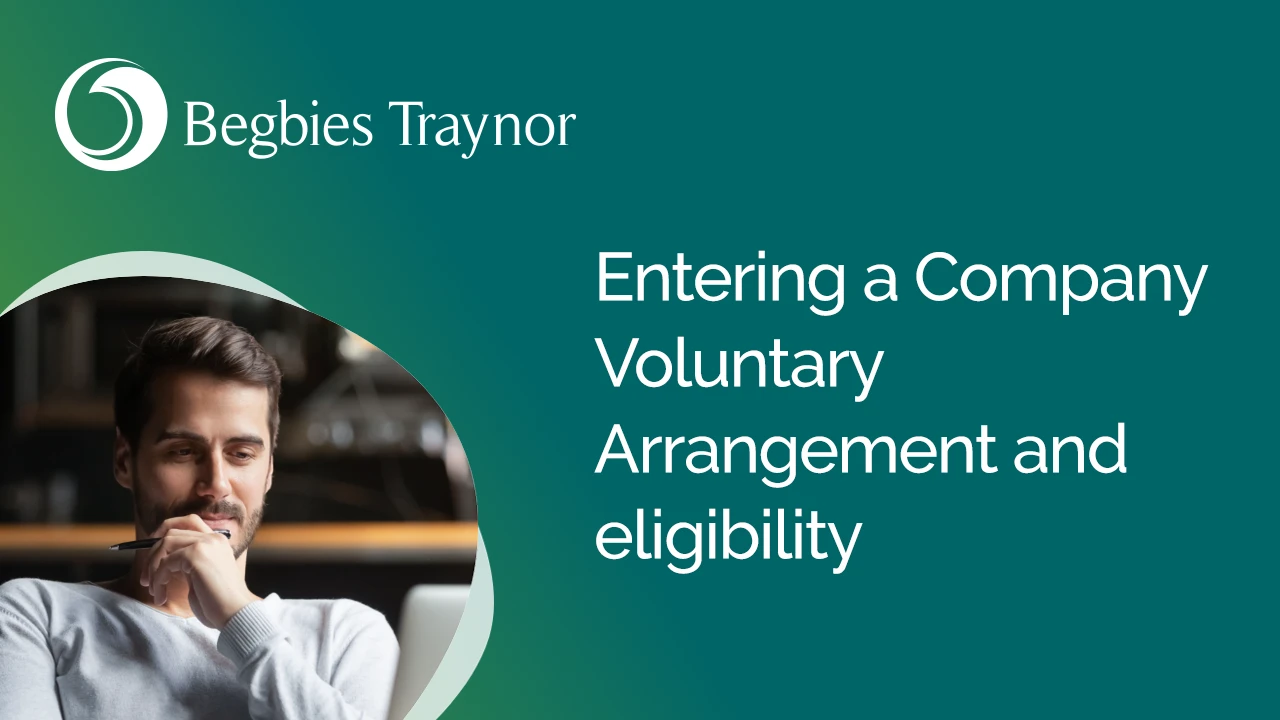Company Voluntary Arrangement (CVA)
Understanding the Company Voluntary Arrangement procedure and eligibility
A CVA is a formal process enabling a compromise to be entered into between a company and its creditors, based on a vote passed by a majority of creditors representing 75% or more in value of those voting on the proposal.
All creditors are then legally bound to accept the terms of the arrangement – including those who were non-voting or did not receive notice of the meeting which provides structure for a proportion of the debts to be repaid over a fixed period of time – typically monthly contributions to the CVA supervisor.

Alternatively the company may look to sell assets and repay creditors from the proceeds. Whichever agreement is put in place, all involved parties are contractually bound to adhere to the terms and conditions set out.
It is a fairly common insolvency solution as an act of recovery; particularly for companies that are struggling under the burden of debts but are still viable businesses. For directors wishing to retain control of the company and attempt to trade out of difficulties, a CVA is likely to be the most suitable solution.
For a CVA to be approved, creditors will need reassuring that the repayment proposals and projections are realistic and the agreement will be overseen by a licensed insolvency practitioner or ‘supervisor’. Where the company proposes to make monthly contributions from income, it is clearly important that it is able to afford them.
Creditors are usually willing to support a CVA - even though they’re unlikely to recover all that they are owed - as opposed to alternative solutions such as company liquidation which would see them receive significantly less.
Once CVA terms have been agreed by creditors, existing contractual payment terms are changed to reflect the terms of the CVA. Agreements are usually reached in situations where creditors stand to gain more by taking this route, rather than forcing a company into liquidation; an added benefit for them being the potential of trading with a viable customer in the future.
Eligibility for a CVA
Although a company must be regarded as insolvent/contingently insolvent, the appointed insolvency practitioner should be satisfied that the business is a ‘going concern’ operating under fundamentally sound practices.
Projected cash flow forecasts will be required as evidence of the company’s ability to meet CVA terms, with clear and accurate financial reporting systems being beneficial to the smooth-running of the process.
Begbies Traynor can help company directors in this situation. We are licensed insolvency practitioners with a wealth of experience in all industries.
What are the benefits of a CVA?
- It is a flexible, legally-binding tool that offers protection from creditors
- The company is able to carry on trading, and can restructure to improve overall profitability
- Debt repayments are consolidated into one single monthly payment
- Cash flow can quickly improve, providing increased working capital
- Company Voluntary Arrangements can be cheaper than other insolvency options. Costs in the range of £5,000 to £10,000 are common, but vary depending on the work involved
- Steps can be taken to reduce outgoings - for example, ending leases and employment contracts
- The company situation is not advertised publicly as in the case of company administration
- If action is taken quickly enough, a CVA can prevent a winding-up petition from taking effect
- A CVA offers reassurance to creditors that some or all of the debt will be repaid
- Creditors may agree to continue trading with the company, albeit under different payment terms such as pro-forma invoices or cash-on-delivery

Find Your Begbies Traynor Group Professional
Use our People Search to find the person you need based on location or skillset.
How does the process work?
The timescale from initial contact with an insolvency practitioner to agreement of a CVA is 6-8 weeks on average. Once an IP has been appointed, it can take around 4 weeks to produce, file in court, and post the final CVA proposal to creditors
Here is a general outline of the CVA process:
- A licensed insolvency practitioner is approached - they will assess the company situation and decide whether a CVA is the most appropriate solution, keeping both business and creditors in mind. Begbies Traynor has many years’ experience of dealing with company insolvencies. We can review your company situation and quickly offer professional advice
- If recommended by the IP, a CVA proposal is drafted following a detailed review of the company, its liabilities and assets as well as creditors and debts. The company directors may agree its terms or request amendments, but the IP must be satisfied that any final proposal has a reasonable chance of success before proceeding
- Upon agreement the final proposal is filed at court, given a legal originating number, printed, and then copies distributed to creditors
- The IP arranges separate decisions of creditors and a meeting of shareholders not less than 14 days following the distribution of the CVA proposal
- The creditors’ meeting provides an opportunity to question the terms of the CVA, although some creditors choose to send a representative rather than attending themselves. Others prefer to vote by post or fax their acceptance or rejection of the proposal
- The proposal is approved if 75% or more of the unsecured creditors participating (by debt value) approve the CVA, and 50% or more of unconnected unsecured creditors (participating in a separate vote) approve the CVA
- A vote is also taken at the shareholders’ meeting, with a majority of 50% or more required for the CVA to be approved
- The IP, acting as Nominee, convenes each decision/meeting and on successful approval issues a report to the court and all creditors within four days. The report details the outcome of each meeting - who was there, plus the results of each vote
- The CVA takes effect as from the date of the Creditors’ Decision – no action can then be taken against the Company by its creditors in respect of CVA debts or unless there is a default for debts moving forward
Advice on Rescue Options
Arrange a free consultation with an insolvency professional at Begbies Traynor – choose a time at your convenience and with no obligation.
Free ConsultationWhat happens if the Company Voluntary Arrangement proposal is rejected by creditors?
Should the CVA be rejected by either shareholders or creditors, you will need to consider alternative insolvency options. Sometimes creditors feel that better returns would be achieved using a different option, or assume that compulsory liquidation is the preferable route.
This is generally not the case in practice, however, as unsecured creditors are placed last in line for repayment in such circumstances. A well-constructed CVA offers at least some recompense, and when compared with the likelihood of receiving a payment via liquidation, can provide the best outcome for creditors.
What are the alternatives if CVA terms fail?
Various options remain even when a CVA is rejected or fails. Which one is most suitable depends on the circumstances of individual businesses, but options may include:
- Entering administration
By entering administration you can protect the company from creditor action, but there is a time limit of eight weeks in which to formulate a plan to rescue/restructure the business. This could include selling it as a going concern if the underlying business is viable and the company has had relatively predictable cash flow on the whole, but there are strict regulations surrounding administration as an option.
- Pre pack administration
Pre pack administration involves marketing the business before an administrator is appointed, to enable a quick sale and minimise the threat of the bad publicity which could affect future trading levels. It is often the case that directors buy the business assets, setting up a new company without debt. Again, strict rules are in place to prevent abuse of this system, and it has to be established beyond doubt by an insolvency practitioner that this solution would provide the best outcome for creditors.
- Creditors’ Voluntary Liquidation (CVL)
If creditors refuse to accept the terms of a CVA, then Company Voluntary Liquidation may be the only way to avoid compulsory winding-up. As we said earlier, the availability of these options vary depending on each business case, but by choosing a Creditors’ Voluntary Liquidation directors are placing creditor interests to the fore.
How Begbies Traynor can help you explore a CVA for your business
As licensed insolvency practitioners, we can help to ensure that the repayment model is viable. We have worked with thousands of distressed companies and we understand that being pursued for unpaid debts is a hugely stressful time and equally recognise that creditors simply want to be paid.
So, if your business is potentially viable but struggling with cash-flow problems or facing threats from creditors such as demands or even a winding-up petition, a Company Voluntary Arrangement could help bring an end to creditor pressure and revive your company.
Further Reading on Company Voluntary Arrangement (CVA)
Contact Begbies Traynor Group
Our Media Centre
Read our latest news, expert opinion pieces and articles covering the the professional and financial sector.




